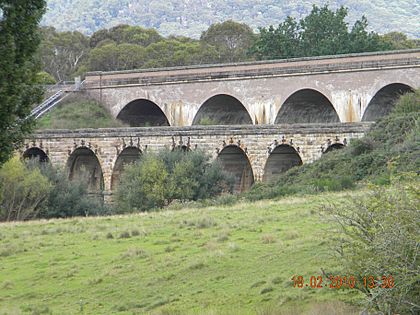Bowenfels rail viaducts facts for kids
Quick facts for kids Bowenfels rail viaducts |
|
|---|---|

The two viaducts, with the 1870 stone viaduct in the foreground and the 1921 brick viaduct in the background; pictured in 2010
|
|
| Coordinates | 33°28′22″S 150°07′38″E / 33.4729°S 150.1271°E |
| Carries | Main Western line |
| Crosses | Farmers Creek |
| Locale | Bowenfels, City of Lithgow, New South Wales, Australia
|
| Owner | RailCorp |
| Characteristics | |
| Design | Arch viaduct |
| Material |
|
| Number of spans |
|
| History | |
| Designer |
|
| Construction begin | 1870 |
| Construction end | 1921 |
| Official name: Bowenfels rail viaducts; Farmers Creek viaducts | |
| Type: | State heritage (built) |
| Designated: | 2 April 1999 |
| Reference #: | 1028 |
| Type: | Railway Bridge/ Viaduct |
| Category: | Transport - Rail |
The Bowenfels rail viaducts are two historic railway bridges in Bowenfels, New South Wales, Australia. They cross Farmers Creek and are part of the important Main Western railway line. These special bridges were built at different times: one in 1870 and another in 1921. They are also known as the Farmers Creek viaducts. These structures are owned by RailCorp. They are protected as part of the New South Wales State Heritage Register. The viaducts are about 159 kilometers (99 miles) west of Sydney's Central Station.
Contents
History of the Bowenfels Viaducts
The older of the two bridges, the stone railway viaduct, was built in 1870. It was made for the single-track railway line that went from Lithgow to Bathurst. This stone bridge is one of the oldest railway arch bridges in New South Wales.
Why a Second Bridge Was Built
By the early 1900s, the single railway track was not enough for all the trains. So, plans were made to add a second track. This new track would also make the railway smoother and straighter.
The first bridge was designed by John Whitton, a famous railway engineer. He wanted to use strong iron girders. But he didn't get enough money for them. So, he chose to build the bridge using stone arches instead.
Later, a big project started in 1910 to build more railway lines. Steel was very expensive to bring in from Britain. Because of this, many new bridges were built using bricks. Most of these bricks came from the State Brickworks at Homebush. This time was known as the "era of the brick arch" because so many brick bridges were built.
The work on the Bowenfels to Wallerawang section was delayed. It finally happened after World War I. The new, second bridge was completed in 1921.
You can see these viaducts from a local road. This road used to be part of the original Great Western Highway.
What the Bridges Look Like
There are two main parts to the Bowenfels rail viaducts.
The 1870 Stone Viaduct
This bridge is made of sandstone. It was built for the first single railway track. It has nine arches that are shaped like half-circles. Each arch is about 0.6 meters (2 feet) thick. The supports, called piers, are made of solid stone. They are built on rock.
Inside the arches, stone rubble fills the space. This helps drain water away from the railway tracks. There is a low stone wall on each side of the bridge.
The 1921 Brick Viaduct
This bridge is made of bricks. It has six clear spans, each about 12.2 meters (40 feet) long. It also has brick wing walls. This bridge was built for the second, double railway track.
How Strong Are They?
Both viaducts are in good condition. They have been well-maintained since they were built.
Why These Bridges Are Important
The Bowenfels rail viaducts are very important to the history of New South Wales.
The 1870 stone viaduct is special because it's one of the oldest stone arch railway bridges in the state. It was designed by John Whitton, who is known as the "father of New South Wales railways." This impressive stone bridge helped extend the railway line to Bathurst and further into western New South Wales. It shows how Whitton chose stone arches when he couldn't use more expensive iron girders.
The 1921 brick viaduct is also important. It was part of the last big railway expansion that used many brick arches. Together, both curved viaducts look very impressive on the edge of historic Bowenfels. The new bridge helped connect western New South Wales to Sydney for transport. With its six long spans and tall brick piers, it's one of the largest brick arch structures on the New South Wales railway system.
Both viaducts are great examples of how bridges were built in their time. They still have their original parts and structure.
The Bowenfels Rail Viaducts were added to the New South Wales State Heritage Register on 2 April 1999. This means they are protected because they are rare and important parts of New South Wales' history.

